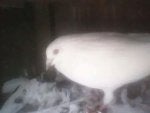What are the differences between Tipplers and High Flyers?
There are a few threads in this forum and in other forums and websites but each one of them seem to have a different ending. Some of them conclude that they are both one and the same - different terms but same breed. Nothing is conclusive. I've been interacting and debating this with few fanciers (some of them are members of this forum) but now I am so confused that I thought it would be best to start the debate all over again with wider participation.
Request the members to post your views and lets try to have a firm outcome this time.
There are a few threads in this forum and in other forums and websites but each one of them seem to have a different ending. Some of them conclude that they are both one and the same - different terms but same breed. Nothing is conclusive. I've been interacting and debating this with few fanciers (some of them are members of this forum) but now I am so confused that I thought it would be best to start the debate all over again with wider participation.
Request the members to post your views and lets try to have a firm outcome this time.






